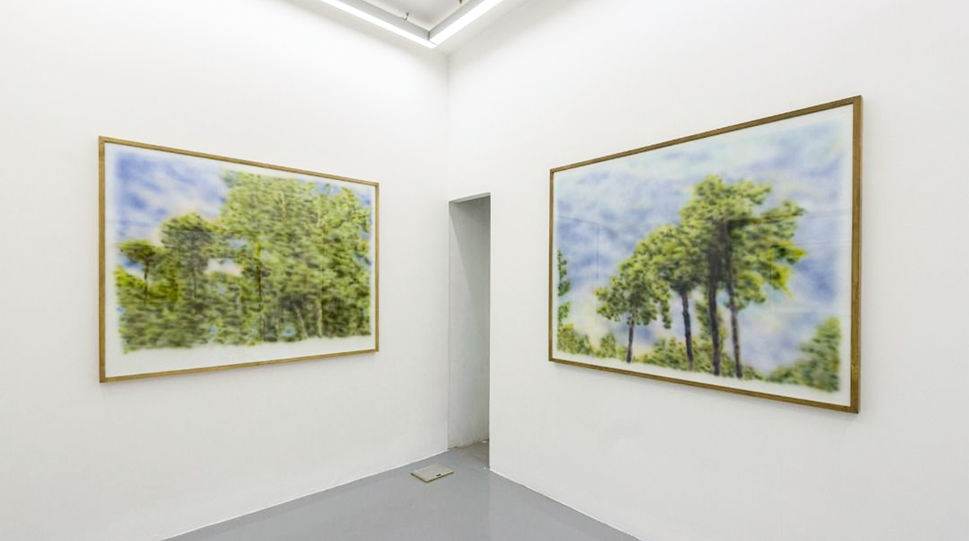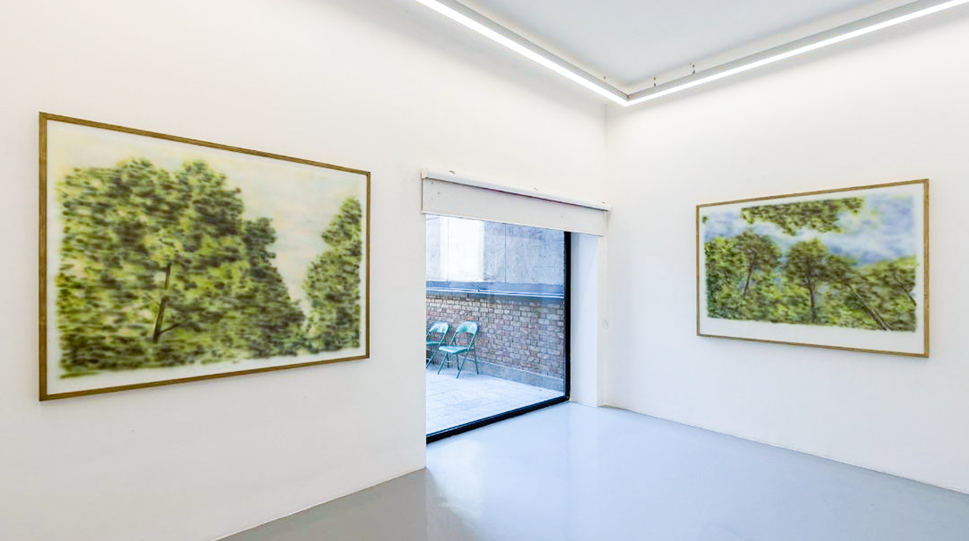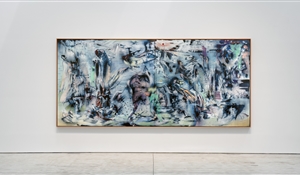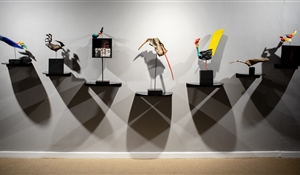"Under Preceding Trees"
28 Nov 2021Original text in Farsi by Abel Hartouni
Translated to English by Omid Armat
The opening of Sale Sharifi's exhibition titled "Under Preceding Trees" was held on October 15, 2021 at Soo Contemporary. His works which were presented in two series called "Trees" and "Flowers" occupied both floors of the gallery. According to the show's title, Sharifi has created these works in continuation of his previous studies on Iran's social, political, and art history, and the importance of the Persian garden. So this show is somehow resuming his previous show "Bygone Glory". The major difference between the two is his practice – that is the use of airbrush – and his insistence on making the study process more visible. In the exhibition's catalog, Sharifi has explained that by focusing on Persian gardens of the Safavid and Qajar periods, he has subjected himself to something he has not ever seen, and has tried to represent the past by using photographs (both from archive and his own) and matching them with texts written by ancient explorers like Chardin. It is also mentioned in the catalog that Persian gardens have turned from private spaces owned by rulers to urban resorts. Unlike his previous series, he has omitted hand-made elements, such as howz and electric lamps, and has concentrated on natural elements and also on the obscurity of history.
Garden has always been an essential element in Persian culture and life and has been favored by Persian rulers since ancient times; that is why many gardens are built throughout Iran which date back to different historical periods, and currently many of them are fully destroyed. Gardens have also had special importance in different aspects of Persian art. It is one of the essential subjects in Persian poems. The garden may be considered as the earthly manifestation of heaven or a garden in the skies which cannot be described within the capacity of this text. Additionally, garden has appeared both objectively and subjectively in Persian poetry, and the concept of garden is used to describe some of its visual properties and also to express love and describe a beloved one using plant elements.
it should also be mentioned that Persian carpet, with all its plant motifs, is actually a garden set under feet. Garden-patterned carpets contain a hand-woven pattern of the Persian garden in which canals, pools, plants, and animals are depicted. Also in miniature paintings, the garden has been pictured as the main location of many events; "Humay Arrives at the Gate of Humayun's Castle" by Junaid Shirazi is an example. Within the mentioned examples, elements like trees and flowers are pictured in detail, just as they are visible in Sharifi's series.

Sale Sharifi | Installation view of "Under Preceding Trees" at Soo Contemporary | Image courtesy: Soo Contemporary
The first series of "Under Preceding Trees" show displays trees. All artworks are the same size and larger than the artworks in his previous series. Here, the artist has looked up at the trees' crowns, where the sky is visible through the twigs and leaves. The location of each painting is specified below it: Ruby Palace, Qajar Palace, Negarestan Palace, Saltanatabad Palace, etc. Using airbrush in order to create an unclear, blurred space, associates with the ambiguity of the past. This issue is easier understood in Iranian historical context, because events and details of different periods are not recorded anywhere.
Looking at the trees' crowns and finding the sky between the twigs and leaves is familiar for anyone who has experienced being in a garden, but the blurry appearance of Sharifi's paintings has distanced this daily experience of ours from the trees within these paintings.

Sale Sharifi | Installation view of "Under Preceding Trees" at Soo Contemporary | Image courtesy: Soo Contemporary
The flowers are displayed in the second floor. In the exhibition's catalog, flower is described as an important element in Iran's visual culture. Flower is of special value for Iranians, both as a metaphor in Persian painting and literature (Rose and Nightingale or gul-o bulbul) for the beloved one, and as a general public interest. Moreover, flower patterns have been used as ornamental elements on walls and stone plates in many palaces and historical buildings (especially after the Safavid dynasty). Sharifi has used these ornamental motifs and tried to recreate them with some slight changes in order to produce this series. Flowers are created using a combination of materials and are placed in a background devoid of any spatial and temporal properties. All paintings are created in the same size and with similar techniques. Here, the stippling technique, which was used in Sale Sharifi's previous works, is applied with more precision and it appears as if they were drawn with color rollerball pen. Furthermore, some videos and notes are displayed which refer to the artist's studying process. The videos are actually montages of Pishdaramad music (Persian prelude music) with images of flowers, trees, gardens, and architectural ornaments, along with texts such as poems and historical facts attached to them.
All of these historical indications in Sharifi's work intersect at one point which is the painting itself. Tracing the paintings' details, such as the stippling of flowers, aggregation of merged surfaces, and watching some stages of the production process of trees (like contour lines of photographs drawn for applying colors), let the viewer engage with the artworks more actively. Stippling technique might be considered as a bridge between his paintings and works of painters in the past. It may be concluded that with his specific vantage point and the blurry appearance of the trees, Sharifi has presented an innovative image of garden in Persian painting. Through picturing the trees, he searches for the pattern of paintings as well as following his curiosities about the history, and he leads our attention towards the history of these trees and, generally, the significance of garden in Iranian culture.









